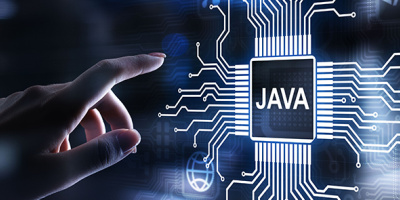The CES show is so vast that we have to use a made-up word to describe it: "ginourmous." I've been to a lot of trade shows, and the only thing I have ever seen that even came close to the size of CES these days was Comdex back in the early '90s. The preliminary attendance numbers help put it in perspective. This year, attendance grew about 10% over last year to approximately 130,000 attendees. There were just under 2,500 exhibitors hawking their goods in 1.4 million square feet of exhibit space. So let's do a little math. If you spent just five minutes with each exhibitor, it would take you a little over 208 hours to visit everybody. No wonder my feet hurt and my voice is gone.
Buried amongst the piles of white papers, glossy sales brochures, and working prototypes, you will find Java. Although it is interesting to me that Sun does not have its own booth, the company is nevertheless present at the show. Take cell phones, for instance. To me, Java technology and cell phones are a great match, and most of the manufacturers and telecom companies apparently agree with me. Let's look at some of the biggies and what they are offering.
Motorola currently offers nine phone models powered by J2ME. However, the latest model, the i730, really stands out. It supports MIDP 2.0 (JSR 118), Mobile Media API (JSR 135), and Wireless Messaging API (JSR 120)--all in a 5.1 ounce package. Other features include access to the onboard GPS, encryption functionality for security, zip functionality for compression, access to the device's date book and calendaring system, and even a lightweight set of 3D rendering tools to show off its 65K color display.
Nokia currently offers a very compelling gadget called the 7700 media device. I would call it a connected PDA on steroids. It has a built-in browser, an image and video viewer, and a nice-sized 640x320 display (although that is a rather odd aspect ratio, it seems to work for this unit). It also supports MIDP 2.0 as well as Wireless Messaging API (JSR-120), the Mobile Media API (JSR 135), and the Bluetooth API (JSR-82 no OBEX).
Siemens offers some of the most unique designs in mobile phones, such as the SX1. In addition to J2ME support, it also has a 640x480 display, an FM radio, and the ability to record up to six hours of broadcast. And if that's not enough, it even includes a built-in camera.
Java technology may not have the mobile phone market cornered, but it's the single biggest player.
Another Java-friendly trend is the networked home, and one of the leaders in networked device interoperability is the Open Services Gateway Initiative (OSGi). The OSGi Alliance, as they like to call themselves, has the mission to "...specify, create, advance, and promote an open Service Platform for the delivery and management of multiple applications and services to all types of networked devices in home, vehicle, mobile, and other environments." OSGi has an impressive membership list, including IBM, Motorola, Nokia, Texas Instruments, Toshiba, Oracle, Sharp, Siemens, Panasonic, Sun and many others. The OSGi execution environment is entirely Java-based.
Author's Note: This is a bit off-subject, but it's impossible to go to CES without talking a little about the non-Java side of things. Keep in mind that most of the media coverage that you see about a trade show like CES is biased. Last year, I watched in horror as a major network negotiated with a tech company on how much money the tech company would pay to have a technology spotlight piece done on its product. So I would like to point out that I have no direct affiliation with any company at CES and the opinions stated here are my own.
Hardware Is Hot; Software Is Not: You can see this just in the attendance numbers I mentioned. People still love software, but gadgets give you more bang for your buck. Besides, can you really get excited about another new version of Windows?
Convergence: By "convergence," I mean combining what used to be two separate devices into one. Some examples are mobile phones or camcorders that take pictures, or DVD players with built-in hard drives that act like a Digital Video Recorder (DVR). However, convergence seems to be happening slowly and often isn't worth it. Is there any advantage to buying a camcorder that takes digital stills, when it costs more than buying a camcorder and a digital camera separately, especially when the number of megapixels is less than half of that of the average digital camera? So I'm a convergence skeptic. I think it's coming, but it's not as close as people think.
Best Overall Product: I picked this product based on overall value and longevity. It's easy at CES to get excited about a new widget with a big price tag, but to be practical, here is my choice: the Canon Digital Rebel. Canon has taken the design of what I think is the best consumer-oriented SLR camera in the world and made it digital.
Best HD TV Technology: Expect Liquid Crystal on Silicon (LCOS) to enter as the new choice for HD TV. The picture rivals or exceeds plasma, and it's much cheaper to produce. The first few models should hit the market late this year.
Best Emerging Technology: Wireless everything. Sharp has a wireless version of its Aquos LCD TV that runs on batteries. Since the broadcast signal is sent from its base unit, you can watch cable TV or DVDs from wherever you want in your house.
Best Swag: Inflatable green aliens at the Fusion Car Audio booth.
Most Unique: Powergrid Fitness' kiloWatt System is a workout machine for your XBOX or PlayStation2. My arms are still sore.
Final Thought
The focus of CES was that everything is going digital, but digital is not always better. Take my TiVo, for example. I couldn't live without it; it records all my shows while I'm away at CES, and when I come back, I can blow through them commercial-free in my spare time. But there is a sacrifice to be made. The encoded digital image that I see on my TiVo, even on the best encoding setting, is not as good as the original analog signal sent to me by my cable company. Digital is not always better.
Mars
On January 3, 2004, Spirit landed on Mars. Like most other geeks, I was riveted to my Web browser for the next several days to see the grayscale and then color images sent back by the lander. This is the most excited I have been about space exploration in quite a while, and Java helped make it all happen.
NASA has built a browser called Maestro for viewing and navigating the surface of Mars. Maestro uses the Java 3D API and Java Advanced Imaging API to help navigate the surface of Mars. Although we can't get the actual program that NASA and JPL use to analyze the data coming back, we can get a stripped-down version of the real thing. When you download the application, you also get some sample data to try out. NASA has started releasing the actual data from Mars, and you can load it into Maestro running on your desktop and see for yourself what the landing site and Sleepy Hollow look like. After you have downloaded Maestro, follow the links to download the updates, and you will soon be driving your rover around Mars. A special thanks goes to my alma mater, San Diego State University, for hosting the Web site.
So what's next for Java, JPL, and NASA? According to James Gosling, the godfather of Java, who gave a talk last year at JavaOne about a rover based on a real-time version of Java, that would be landing on the red planet in 2008.
JavaOne on the Horizon
I have to admit that I get excited about trade shows and conventions. Both the anticipation of what will be new this year and the burst of energy and excitement that get instilled in me at the shows makes me happy that we all live and work in a technology-dominated world. So what's next? JavaOne, of course, in June at Moscone Center in San Francisco.
Conclusion
It's an exciting time to be working with Java technology. Java really has become the "write once, run anywhere" language that Sun set out to create. Whether it is on your desktop computer, set top box, cell phone, or toaster, Java has become ubiquitous--even on Mars. I hope to see you all at JavaOne.
Michael J. Floyd is the Software Engineering Manager for DivXNetworks. He is also a consultant for San Diego State University and can be reached at






















 More than ever, there is a demand for IT to deliver innovation. Your IBM i has been an essential part of your business operations for years. However, your organization may struggle to maintain the current system and implement new projects. The thousands of customers we've worked with and surveyed state that expectations regarding the digital footprint and vision of the company are not aligned with the current IT environment.
More than ever, there is a demand for IT to deliver innovation. Your IBM i has been an essential part of your business operations for years. However, your organization may struggle to maintain the current system and implement new projects. The thousands of customers we've worked with and surveyed state that expectations regarding the digital footprint and vision of the company are not aligned with the current IT environment. TRY the one package that solves all your document design and printing challenges on all your platforms. Produce bar code labels, electronic forms, ad hoc reports, and RFID tags – without programming! MarkMagic is the only document design and print solution that combines report writing, WYSIWYG label and forms design, and conditional printing in one integrated product. Make sure your data survives when catastrophe hits. Request your trial now! Request Now.
TRY the one package that solves all your document design and printing challenges on all your platforms. Produce bar code labels, electronic forms, ad hoc reports, and RFID tags – without programming! MarkMagic is the only document design and print solution that combines report writing, WYSIWYG label and forms design, and conditional printing in one integrated product. Make sure your data survives when catastrophe hits. Request your trial now! Request Now. Forms of ransomware has been around for over 30 years, and with more and more organizations suffering attacks each year, it continues to endure. What has made ransomware such a durable threat and what is the best way to combat it? In order to prevent ransomware, organizations must first understand how it works.
Forms of ransomware has been around for over 30 years, and with more and more organizations suffering attacks each year, it continues to endure. What has made ransomware such a durable threat and what is the best way to combat it? In order to prevent ransomware, organizations must first understand how it works. Disaster protection is vital to every business. Yet, it often consists of patched together procedures that are prone to error. From automatic backups to data encryption to media management, Robot automates the routine (yet often complex) tasks of iSeries backup and recovery, saving you time and money and making the process safer and more reliable. Automate your backups with the Robot Backup and Recovery Solution. Key features include:
Disaster protection is vital to every business. Yet, it often consists of patched together procedures that are prone to error. From automatic backups to data encryption to media management, Robot automates the routine (yet often complex) tasks of iSeries backup and recovery, saving you time and money and making the process safer and more reliable. Automate your backups with the Robot Backup and Recovery Solution. Key features include: Business users want new applications now. Market and regulatory pressures require faster application updates and delivery into production. Your IBM i developers may be approaching retirement, and you see no sure way to fill their positions with experienced developers. In addition, you may be caught between maintaining your existing applications and the uncertainty of moving to something new.
Business users want new applications now. Market and regulatory pressures require faster application updates and delivery into production. Your IBM i developers may be approaching retirement, and you see no sure way to fill their positions with experienced developers. In addition, you may be caught between maintaining your existing applications and the uncertainty of moving to something new. IT managers hoping to find new IBM i talent are discovering that the pool of experienced RPG programmers and operators or administrators with intimate knowledge of the operating system and the applications that run on it is small. This begs the question: How will you manage the platform that supports such a big part of your business? This guide offers strategies and software suggestions to help you plan IT staffing and resources and smooth the transition after your AS/400 talent retires. Read on to learn:
IT managers hoping to find new IBM i talent are discovering that the pool of experienced RPG programmers and operators or administrators with intimate knowledge of the operating system and the applications that run on it is small. This begs the question: How will you manage the platform that supports such a big part of your business? This guide offers strategies and software suggestions to help you plan IT staffing and resources and smooth the transition after your AS/400 talent retires. Read on to learn:
LATEST COMMENTS
MC Press Online